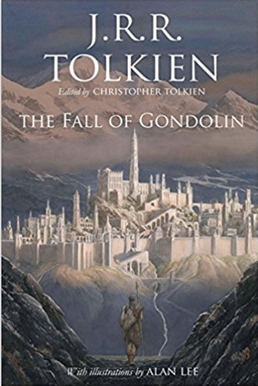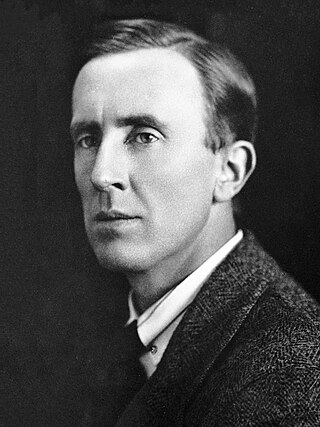
William Morris was a British textile designer, poet, artist, fantasy writer, architectural conservationist, printer, translator and socialist activist associated with the British Arts and Crafts Movement. He was a major contributor to the revival of traditional British textile arts and methods of production. His literary contributions helped to establish the modern fantasy genre, while he helped win acceptance of socialism in fin de siècle Great Britain.
Valinor or the Blessed Realms is a fictional location in J. R. R. Tolkien's legendarium, the home of the immortal Valar on the continent of Aman, far to the west of Middle-earth; he used the name Aman mainly to mean Valinor. It included Eldamar, the land of the Elves, who as immortals were permitted to live in Valinor.
In J. R. R. Tolkien's fictional legendarium, Beleriand was a region in northwestern Middle-earth during the First Age. Events in Beleriand are described chiefly in his work The Silmarillion, which tells the story of the early ages of Middle-earth in a style similar to the epic hero tales of Nordic literature, with a pervasive sense of doom over the character's actions. Beleriand also appears in the works The Book of Lost Tales, The Children of Húrin, and in the epic poems of The Lays of Beleriand.

In Greek mythology, Oenone was the first wife of Paris of Troy, whom he abandoned for Helen. Oenone was also the ancient name of an island, which was later named after Aegina, daughter of the river god Asopus.

The Adventures of Tom Bombadil is a 1962 collection of poetry by J. R. R. Tolkien. The book contains 16 poems, two of which feature Tom Bombadil, a character encountered by Frodo Baggins in The Lord of the Rings. The rest of the poems are an assortment of bestiary verse and fairy tale rhyme. Three of the poems appear in The Lord of the Rings as well. The book is part of Tolkien's Middle-earth legendarium.

Pearl is a late 14th-century Middle English poem that is considered one of the most important surviving Middle English works. With elements of medieval allegory and dream vision genre, the poem is written in a North-West Midlands variety of Middle English and highly—though not consistently—alliterative; there is a complex system of stanza linking and other stylistic features.
Ælfwine the mariner is a fictional character found in various early versions of J. R. R. Tolkien's Legendarium. Tolkien envisaged Ælfwine as an Anglo-Saxon who visited and befriended the Elves and acted as the source of later mythology. Thus, in the frame story, Ælfwine is the stated author of the various translations in Old English that appear in the twelve-volume The History of Middle-earth edited by Christopher Tolkien.

J. R. R. Tolkien's The Fall of Gondolin is one of the stories which formed the basis for a section in his posthumously-published work, The Silmarillion, with a version later appearing in The Book of Lost Tales. In the narrative, Gondolin was founded by King Turgon in the First Age; the city was carefully hidden, enduring for centuries before being betrayed and destroyed.

The Round World Version is an alternative creation myth to the canonical version of J.R.R. Tolkien's legendarium as it appears in The Silmarillion and The Lord of the Rings. In the canonical version, the Earth was created flat and was changed to round as a cataclysmic event during the Second Age in order to prevent direct access by Men to Valinor, home of the immortals. In the Round World Version, the Earth is created spherical from the beginning.

"The Man in the Moon Stayed Up Too Late" is J. R. R. Tolkien's imagined original song behind the nursery rhyme "Hey Diddle Diddle ", invented by back-formation. It was first published in Yorkshire Poetry magazine in 1923, and was reused in extended form in the 1954–55 The Lord of the Rings as a song sung by Frodo Baggins in the Prancing Pony inn. The extended version was republished in the 1962 collection The Adventures of Tom Bombadil.
Tail rhyme is a family of stanzaic verse forms used in poetry in French and especially English during and since the Middle Ages, and probably derived from models in medieval Latin versification.
Tolkien's legendarium is the body of J. R. R. Tolkien's mythopoeic writing, unpublished in his lifetime, that forms the background to his The Lord of the Rings, and which his son Christopher summarized in his compilation of The Silmarillion and documented in his 12-volume series The History of Middle-earth. The legendarium's origins reach back to 1914, when Tolkien began writing poems and story sketches, drawing maps, and inventing languages and names as a private project to create a unique English mythology. The earliest story drafts are from 1916; he revised and rewrote these for most of his adult life.
The cosmology of J. R. R. Tolkien's legendarium combines aspects of Christian theology and metaphysics with pre-modern cosmological concepts in the flat Earth paradigm, along with the modern spherical Earth view of the Solar System.

Middle-earth is the setting of much of the English writer J. R. R. Tolkien's fantasy. The term is equivalent to the Miðgarðr of Norse mythology and Middangeard in Old English works, including Beowulf. Middle-earth is the human-inhabited world, that is, the central continent of the Earth, in Tolkien's imagined mythological past. Tolkien's most widely read works, The Hobbit and The Lord of the Rings, are set entirely in Middle-earth. "Middle-earth" has also become a short-hand term for Tolkien's legendarium, his large body of fantasy writings, and for the entirety of his fictional world.
"Fastitocalon" is a medieval-style poem by J. R. R. Tolkien about a gigantic sea turtle. The setting is explicitly Middle-earth. The poem is included in The Adventures of Tom Bombadil.

The Story of Sigurd the Volsung and the Fall of the Niblungs (1876) is an epic poem of over 10,000 lines by William Morris that tells the tragic story, drawn from the Volsunga Saga and the Elder Edda, of the Norse hero Sigmund, his son Sigurd and Sigurd's wife Gudrun. It sprang from a fascination with the Volsung legend that extended back twenty years to the author's youth, and had already resulted in several other literary and scholarly treatments of the story. It was Morris's own favorite of his poems, and was enthusiastically praised both by contemporary critics and by such figures as T. E. Lawrence and George Bernard Shaw. In recent years it has been rated very highly by many William Morris scholars, but has never succeeded in finding a wide readership on account of its great length and archaic diction. It has been seen as an influence on such fantasy writers as Andrew Lang. The Story of Sigurd is available in modern reprints, both in its original form and in a cut-down version, but there is no critical edition.
Tolkien's frame stories are the narrative devices that J. R. R. Tolkien chose to use throughout his Middle-earth writings, especially his legendarium, to make the works resemble a genuine mythology written and edited by many hands over a long period of time. He described in detail how his fictional characters wrote their books and transmitted them to others, and showed how later in-universe editors annotated the material.

Scholars have identified numerous themes in J. R. R. Tolkien's Middle-earth writings, among them paganism. Despite Tolkien's assertion that The Lord of the Rings was a fundamentally Christian work, paganism appears in that book and elsewhere in his fictional world of Middle-earth in multiple ways. These include a pantheon of god-like beings, the Valar, who function like the Norse gods, the Æsir; the person of the wizard Gandalf, who Tolkien stated in a letter is an "Odinic wanderer"; Elbereth, the Elves' "Queen of the Stars", associated with Venus; animism, the way that the natural world seems to be alive; and a Beowulf-like "northern courage" which is determined to press on, no matter how bleak the outlook.

J. R. R. Tolkien took part in the First World War, known then as the Great War, and began his fantasy Middle-earth writings at that time. The Fall of Gondolin was the first prose work that he created, and it contains detailed descriptions of battle and streetfighting. He continued the dark tone in much of his legendarium, as seen in The Silmarillion. The Lord of the Rings, too, has been described as a war book.











